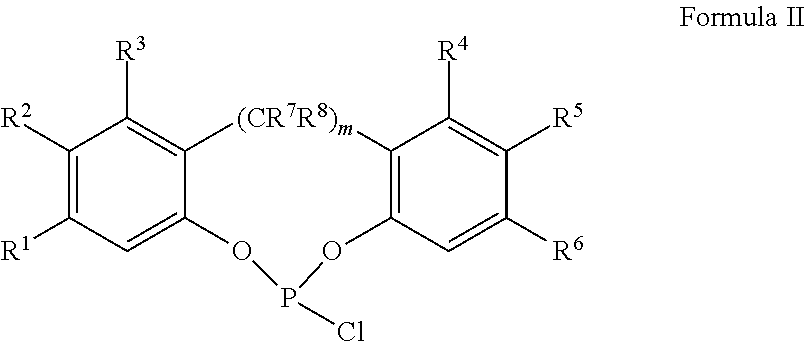Slurry process for synthesis of bisphosphites and situ use thereof for producing bisphosphite
a technology of slurry and bisphosphite, which is applied in the field of process for preparation of phosphoromonochloridites, and to, and can solve the problems of reducing the yield of phosphoromonochloridites, increasing costs, and increasing the production rate of 4-chlorobutanol
- Summary
- Abstract
- Description
- Claims
- Application Information
AI Technical Summary
Benefits of technology
Problems solved by technology
Method used
Image
Examples
example 1
Preparation of 1,1′-biphenyl-2,2′-diyl phosphoromonochloridite
2,2′-Biphenol (6.2 g, 33 mmol) is charged into a nitrogen purged, dry 250 ml, 3-necked round-bottom flask equipped with a septum port, a magnetic stir bar, and a reflux condenser, which is topped with a nitrogen inlet and a vent line to a scrubber. Degassed anhydrous toluene (50 ml, 43 g) is added and the resulting slurry is cooled with an ice bath to 0° C., followed by addition of PCl3 (7.1 g, 51 mmol) and then pyridine (0.1 ml, 1 mmol). The resulting slurry, which contains solid 2,2′-biphenol, dissolved 2,2′-biphenol, PCl3 and toluene, is stirred while being warmed to 35° C. over a period of 60 minutes and then stirred at 35° C. overnight, during which time the solid dissolves to give a clear solution. 31P NMR analysis shows only surplus PCl3 and 1,1′-biphenyl-2,2′-diyl phosphoromonochloridite (δ=180.5 ppm) with less than 5 mole percent impurities. The solution is distilled up to 94° C. to remove excess PCl3 (bp=76°).
example 2
Preparation of 6,6′-(3,3′,5,5′-tetra-tert-butylbiphenyl-2,2′-diyl)bis(oxy)didibenzo[d,f][1,3,2]-dioxaphosphepine
Powders of 2,2′-biphenol (6.25 g, 0.0335 moles) and 3,3′,5,5′-tetra-tert-butyl-2,2′-biphenol (iso-BHT-diol, 6.80 g, 0.0166 moles) are charged into a nitrogen-purged, dry, 250 ml, 3-necked round-bottom flask, equipped with a nitrogen inlet and a vent line to a scrubber, a septum port, and a magnetic stir bar. The powders are degassed and then toluene (50 ml) is added to obtain a slurry. The slurry is cooled to ice temperature (0° C.). Phosphorous trichloride (PCl3, 7.1 g, 0.051 moles) is added into the cooled slurry, followed by addition of pyridine (0.1 ml (0.001 mole). The resulting slurry is stirred while warming to ambient temperature over a period of 60 minutes then stirred overnight at 35° C., over which time the solids are dissolved to give a clear light yellow solution. 31P NMR analysis shows only excess PCl3 and phosphoromonochloridite (δ=180.5 ppm) with less than ...
embodiment 36
37. The embodiment 36, wherein the nitrogen base is selected from the group consisting of pyridine, trialkylamine, and N,N-dialkylaniline, wherein any alkyl group is preferably a C1-C15 alkyl.
38. Any one of embodiments 19 to 37, wherein the nitrogen base added into the second mixture in step (c) is in an amount sufficient to provide a molar ratio of the nitrogen base to the second aromatic diol of advantageously at least 2.0:1, preferably at least 2.1:1, more preferably at least 2.2:1, and advantageously less than 3.0:1, preferably less than 2.9:1, and more preferably less than 2.8:1
PUM
| Property | Measurement | Unit |
|---|---|---|
| boiling point | aaaaa | aaaaa |
| boiling point | aaaaa | aaaaa |
| total pressure | aaaaa | aaaaa |
Abstract
Description
Claims
Application Information
 Login to View More
Login to View More - R&D
- Intellectual Property
- Life Sciences
- Materials
- Tech Scout
- Unparalleled Data Quality
- Higher Quality Content
- 60% Fewer Hallucinations
Browse by: Latest US Patents, China's latest patents, Technical Efficacy Thesaurus, Application Domain, Technology Topic, Popular Technical Reports.
© 2025 PatSnap. All rights reserved.Legal|Privacy policy|Modern Slavery Act Transparency Statement|Sitemap|About US| Contact US: help@patsnap.com



